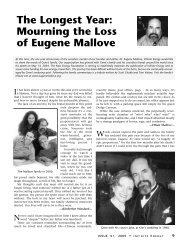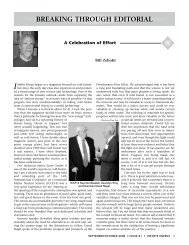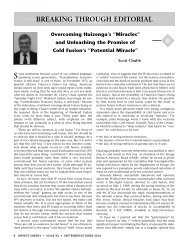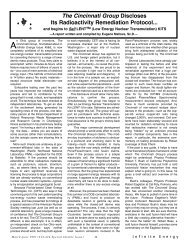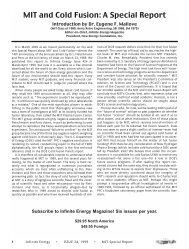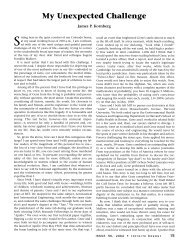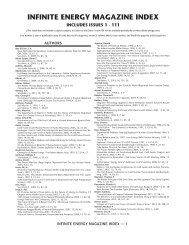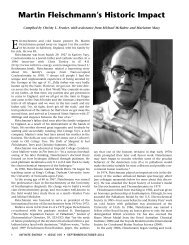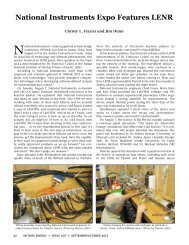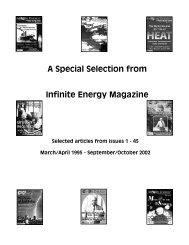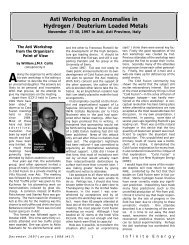Summary of ICCF14 - Infinite Energy Magazine
Summary of ICCF14 - Infinite Energy Magazine
Summary of ICCF14 - Infinite Energy Magazine
Create successful ePaper yourself
Turn your PDF publications into a flip-book with our unique Google optimized e-Paper software.
ideas presented about transmutation during the workshop<br />
may become part <strong>of</strong> mainstream science.<br />
The most important sessions took place on Monday and<br />
Tuesday morning. On Monday, Dr. Mitchell Swartz (JET<br />
<strong>Energy</strong>) and Dr. Shaul Lesin (Energetics Technologies) presented<br />
extremely important excess heat measurement<br />
results. On Tuesday morning there were three important sessions:<br />
“Gas and Fast Loading,” “Honoring Yoshiaki Arata,”<br />
and “Honoring Stanislaw Szpak.” The most significant<br />
results were those presented during the session titled,<br />
“Honoring Yoshiaki Arata.” Many conference attendees<br />
expressed interest in the talks that were scheduled as a result<br />
<strong>of</strong> preliminary reports that had appeared in the popular<br />
press in response to a press conference (referred to above)<br />
held on May 22, in which Pr<strong>of</strong>essor Arata announced that he<br />
and Y.-C. Zhang had been able to create excess heat and<br />
helium-4, as a result <strong>of</strong> the FPE, on-demand, using a device<br />
that does not require any input power or energy once the<br />
experiment is pressurized. Prior to Arata’s presentation,<br />
Talbot Chubb provided background material about Arata<br />
and an overview and interpretation <strong>of</strong> the work.<br />
Figure 1 (from Dr. Chubb’s presentation) shows a plot <strong>of</strong> a<br />
typical time history <strong>of</strong> temperature measurements during<br />
Pr<strong>of</strong>essor Arata’s experiments. In the figure, there are three<br />
sets <strong>of</strong> curves labeled A (associated with the two upper<br />
curves), C (the third highest curve), and D. In the plots associated<br />
with A and C, the temperature is shown, as a function<br />
<strong>of</strong> time, immediately at the boundary <strong>of</strong> (in the case <strong>of</strong> A)<br />
and inside (in A and C) a nm-scale size palladium (Pd) sample<br />
in the presence <strong>of</strong> an insulating oxide, ZrO 2 , after a gas<br />
is loaded into it (by applying a pressure <strong>of</strong> ~100 atm). In the<br />
two curves associated with A, the Pd/ZrO 2 is loaded with D 2 ,<br />
and the temperature inside the sample (labeled T in ) is shown<br />
in the upper curve; immediately below this curve, a second<br />
curve is shown <strong>of</strong> the temperature (labeled T s ) at the boundary<br />
<strong>of</strong> the stainless steel flask (the subscript “s” in T s is used<br />
as a short-hand for “stainless steel”) that contains the gas<br />
and the sample. In the curve associated with C, the temperature<br />
(comparable to the highest curve associated with A,<br />
and labeled T in ) is plotted for a situation in which ordinary<br />
hydrogen, H 2 , is loaded into the Pd/ZrO 2 sample. The third<br />
plot, labeled D, shows the time history <strong>of</strong> ambient<br />
temperature <strong>of</strong> the room where the experiment was<br />
conducted.<br />
Talbot Chubb pointed out that both runs (involving<br />
D 2 in the two temperature plots associated with A,<br />
and H 2 in the plot associated with C) provide evidence<br />
<strong>of</strong> chemical heat (associated with the fact that<br />
the values <strong>of</strong> the temperature in and near the sample<br />
at the beginning <strong>of</strong> each run are greater than room<br />
temperature during the first nine hours <strong>of</strong> the experiment).<br />
He also pointed out, however, that after 10<br />
hours during the H 2 run (plot C), the temperature<br />
inside (T in ) the sample had fallen to room temperature<br />
(plot D), while a similar asymptotic behavior<br />
(either in the temperature, T in , inside the sample, or<br />
the temperature T s , at the boundary <strong>of</strong> the stainless<br />
steel flask that holds the sample) does not take place<br />
during the D 2 run (shown by the behavior <strong>of</strong> the<br />
highest two curves associated with A). In particular,<br />
after 33 hours, the average value <strong>of</strong> the “reactor temperature”<br />
T reactor ~ T s + T in<br />
2<br />
asymptotically appears to approach the limit, T reactor ~(T room<br />
+ 1.6°C), where T room is the value <strong>of</strong> the temperature <strong>of</strong> the<br />
room (associated with the plot labeled D). After approaching<br />
this asymptotic limit, T reactor remains constant for hundreds<br />
<strong>of</strong> hours.<br />
The only plausible explanation for the cause <strong>of</strong> the<br />
observed temperatures is that it occurs as a result <strong>of</strong> a nuclear<br />
reaction. In particular, the temperature difference, T reactor -<br />
T room ~1.6°C, is maintained without any external input<br />
power or input energy. The conditions associated with lack<br />
<strong>of</strong> input power and input energy which are responsible for<br />
this temperature difference are analogous to the comparable<br />
conditions that appear to be present in the temperature differences<br />
that occur in the phenomenon that has been called<br />
“heat after death” (in which excess heat persists in the<br />
absence <strong>of</strong> electrolytic input current during electrolysis<br />
experiments). However, there is an important, obvious physical<br />
difference in how the experiments are set-up: none <strong>of</strong><br />
the complicating factors (and potential sources <strong>of</strong> error)<br />
associated with electrical currents, electricity, or electrolysis<br />
are involved. The effect is triggered entirely by subjecting<br />
nm scale powders <strong>of</strong> Pd/ZrO 2 to a pressurized (~100 atm)<br />
form <strong>of</strong> D 2 gas.<br />
During the Monday morning session on excess heat,<br />
Mitchell Swartz presented results from a second set <strong>of</strong><br />
extremely important experiments, demonstrating that it is<br />
now possible to create excess heat and power, with a good<br />
redundant set <strong>of</strong> measurements confirming the excess heat.<br />
These results are also important because the techniques that<br />
he employs for calibrating, analyzing, and understanding his<br />
heat measurements have provided important information<br />
for identifying new effects and forms <strong>of</strong> heat.<br />
Swartz began his talk by describing a series <strong>of</strong> experiments<br />
performed with a low power electrolytic device that he refers<br />
to as a palladium Phusor TM . These low to moderate power<br />
devices can create low energy nuclear reactions through a<br />
process he refers to as lattice assisted nuclear reaction<br />
(LANR). He presented data showing evolution <strong>of</strong> his work on<br />
a system which “began with wires and rods,” used several<br />
metals and shapes over years and evolved to an open spiral<br />
palladium Phusor cathode. He and his co-worker Gayle<br />
Figure 1. Typical time history <strong>of</strong> temperature measurements during Arata<br />
experiments.<br />
SEPTEMBER/OCTOBER 2008 • ISSUE 81 • INFINITE ENERGY 3



